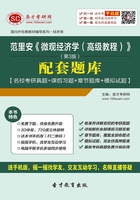
第2章 利润最大化
1.利用库恩-塔克定理求解对边界解也成立的利润最大化或成本最小化条件。
Use the Kuhn-Tucker theorem to derive conditions for profit maximization and cost minimization that are valid even for boundary solutions, i.e., when some fact is not used.
解:对于利润最大化,根据库恩-塔克定理可知最优解 必然满足以下三个条件:
必然满足以下三个条件:

这样,对任意的 ,必有
,必有 ;如果
;如果 ,那么可以断言
,那么可以断言 (注意,不是严格的等号)。否则如果
(注意,不是严格的等号)。否则如果 ,那么增加第
,那么增加第 种要素的投入还会提高厂商的利润,这就和
种要素的投入还会提高厂商的利润,这就和 是利润最大化的最优解相矛盾。综上可知,对于边界解,利润最大化的必要条件是:
是利润最大化的最优解相矛盾。综上可知,对于边界解,利润最大化的必要条件是:

厂商的成本最小化问题的库恩—塔克条件为:

这样对任意的 ,必有
,必有 以及
以及 ;如果
;如果 ,则
,则 ,从而
,从而 ;综上可知,对于边界解,成本最优化的必要条件为:
;综上可知,对于边界解,成本最优化的必要条件为:

2.证明对表现出规模报酬递增的技术,只要有一点产生正利润,就不存在利润最大化束。
Show that a profit-maximizing bundle will typically not exist for a technology that exhibits increasing returns to scale as long as there is some point that yields a positive profit.
证明:假设 是利润最大化约束,此时有正的利润
是利润最大化约束,此时有正的利润 。由于规模报酬递增,则有
。由于规模报酬递增,则有 ,对于
,对于
 ,有
,有 ,与利润最大化相矛盾。因此,
,与利润最大化相矛盾。因此, 不可能是利润最大化约束。
不可能是利润最大化约束。
3.计算出技术 的利润函数,并证明它对
的利润函数,并证明它对 是齐次且凸的。
是齐次且凸的。
Calculate explicitly the profit function for the technology  ,for
,for  and verify that it is homogeneous and convex in
and verify that it is homogeneous and convex in  .
.
答:利润最大化问题为:

一阶条件为: ,得到要素需求函数为:
,得到要素需求函数为: ,将要素需求函数代入目标函数即求得最大化的利润函数为:
,将要素需求函数代入目标函数即求得最大化的利润函数为:

下面证明齐次性,注意到对任意

可见 是一个一次齐次函数。
是一个一次齐次函数。
在计算海赛矩阵之前,以下列方式把利润函数分解为:
 ,其中
,其中 是严格正的,
是严格正的, 。
。
海赛矩阵可以写成:

这一矩阵的主子式为: 和0。所以,海赛矩阵是一个正半定矩阵,这意味着
和0。所以,海赛矩阵是一个正半定矩阵,这意味着 关于
关于 是凸的。
是凸的。
4.令 是两要素生产函数,
是两要素生产函数, 和
和 是它们各自的价格。证明要素份额
是它们各自的价格。证明要素份额 对
对 的弹性是
的弹性是 。
。
Let  be a production function with two factors and let
be a production function with two factors and let  and
and  be their respective prices. Show that the elasticity of the factor share
be their respective prices. Show that the elasticity of the factor share with respect to
with respect to  is given by
is given by  .
.
证明:根据利润最大化可以得到技术替代率为: ,注意到:
,注意到:

因此有: 。
。
5.证明要素份额对 的弹性是
的弹性是 。
。
Show that the elasticity of the factor share with respect to  is
is  .
.
证明:从本章第4题中已得: ,上式两边进行微分得:
,上式两边进行微分得:

6.令 是一满足利润最大化弱公理的观察到的选择集合,
是一满足利润最大化弱公理的观察到的选择集合, 和
和 是真实生产集
是真实生产集 的内界和外界。令
的内界和外界。令 是与
是与 相联的利润函数,
相联的利润函数, 是与
是与 相联的利润函数,
相联的利润函数, 是与
是与 相联的利润函数。证明对所有的
相联的利润函数。证明对所有的 而言,
而言, 。
。
Let  for
for  be a set of observed choices that satisfy WAPM,and let
be a set of observed choices that satisfy WAPM,and let  and
and  be the inner and outer bounds to the true production set
be the inner and outer bounds to the true production set . Let
. Let  be the profit function associated with
be the profit function associated with  and
and  be the profit function associated with
be the profit function associated with  ,and
,and  be the profit function associated with
be the profit function associated with  . Show that for all
. Show that for all  ,
,

.
证明:根据定义:

因此对于任一个 ,
, 中最大的
中最大的 不小于
不小于 中最大的
中最大的 值。同理,
值。同理, 中的
中的 的最大值也不小于
的最大值也不小于 中
中 的最大值,因此,有
的最大值,因此,有 。
。
7.生产函数是 ,并且产出价格正规化后等于1。令
,并且产出价格正规化后等于1。令 是生产要素的价格,且
是生产要素的价格,且 。
。
(a)如果 ,利润最大化的一阶条件是什么?
,利润最大化的一阶条件是什么?
(b) 取什么值时,
取什么值时, 的最优值是零?
的最优值是零?
(c) 取什么值时,
取什么值时, 的最优值是10?
的最优值是10?
(d)要素需求函数是什么?
(e)利润函数是什么?
(f)利润函数对 的导数是什么?
的导数是什么?
The production function is  and the price of output is normalized to 1. Let
and the price of output is normalized to 1. Let  be the price of the
be the price of the
 -input. We must have
-input. We must have  .
.
(a)What is the first-order condition for profit maximization if  ?
?
(b)For what values of  will the optimal
will the optimal  be zero?
be zero?
(c)For what values of  will the optimal
will the optimal  be 10?
be 10?
(d)What is the factor demand function?
(e)What is the profit function?
(f)What is the derivative of the profit function with respect to  ?
?
解:(a)利润最大化问题是: ,其一阶条件是:
,其一阶条件是: 。
。
(b)根据第1题的结论,当最优的 为零时,边际利润为负,即利润关于
为零时,边际利润为负,即利润关于 的导数在
的导数在 点必为非正的,否则厂商就会增加
点必为非正的,否则厂商就会增加 的使用量,即:
的使用量,即: ,将
,将 代入,得:
代入,得: 。
。
(c)将 代入一阶条件得:
代入一阶条件得: 。故当
。故当 时,最优的
时,最优的 将为10。
将为10。
(d)由一阶条件解出 ,从而得到要素需求函数为
,从而得到要素需求函数为 ,或者,更确切地说,
,或者,更确切地说, 。
。
(e)将要素需求曲线: 代入目标函数(
代入目标函数( )得到利润函数为:
)得到利润函数为:

(f)(e)中的利润函数对 的导数为
的导数为 。
。